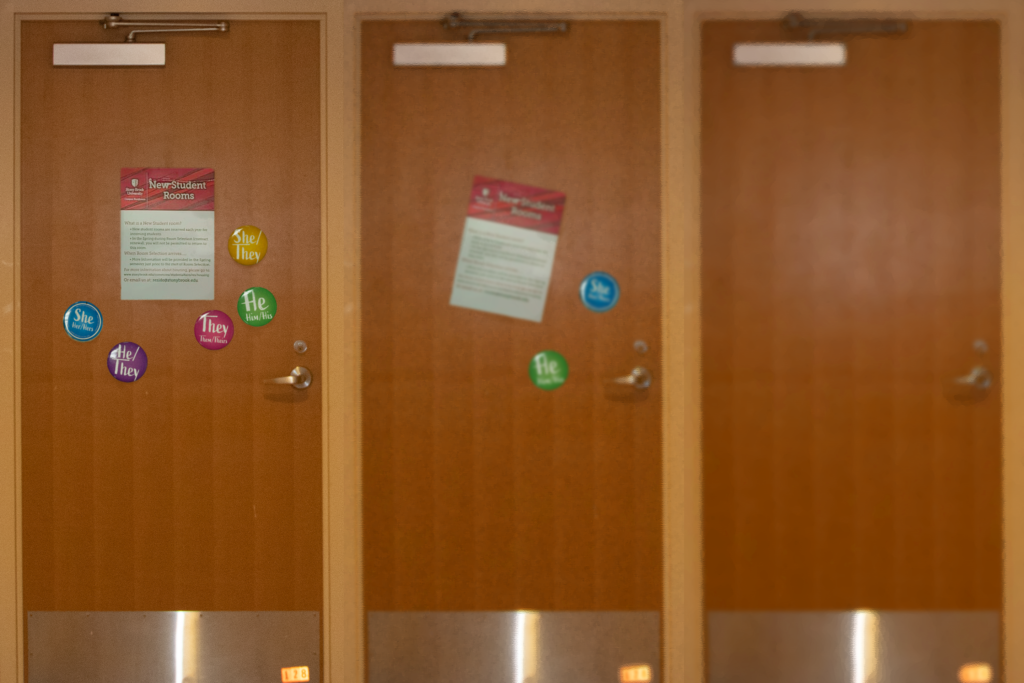Graphic by Ivan Vuong
It is the 1980s: “Gay” is a dirty word, LGBTQ+ stories are absent from mainstream media, same-sex marriage is illegal and a new disease — known first as a “gay man’s pneumonia,” then as the “Gay-Related Immune Deficiency Disorder” and finally as AIDS — is proving deadly. The abstract from a 1986 study deemed the federal response to AIDS to be “uncoordinated, insufficient and inadequate in particular with respect to the support of public health education and the financing of health care for AIDS patients.”
It is the 2020s: Florida education policy blocks topics of sexuality and gender from schools, LGBTQ+ stories are disappearing from bookshelves, gender-affirming care is banned for youth aged 13 through 18 in 22 states, transgender people are being barred from sports teams, anti-LGBTQ+ extremism is on the rise and Supreme Court Justice Clarence Thomas has mentioned revisiting Obergefell v. Hodges — the landmark Supreme Court case affirming the right to same-sex marriage in America. Revisiting it with the intent to overturn it would put the legality of same-sex marriage in the hands of states.
At the university level, LGBTQ+ students are fighting against gender-segregated housing. In April 2023, freshmen students living in Stony Brook University’s Gender-Inclusive Housing (GIH) corridor in Wagner Hall sent a long, detailed email to Campus Housing. The email addressed inequalities experienced by transgender and gender non-conforming students in on-campus housing at Stony Brook. In addition to protesting the comparatively few GIH dorms, the students described the unsafe environment of the Wagner GIH corridor.
“Within the first week of being at Stony Brook, a cisgendered man sexually assaulted one of our trans dormmates and the resulting events led to the survivor transferring out of the school while the filed Title IX [complaint] did nothing about the assaulter,” the students wrote. “Another case of sexual harassment includes a cisgendered woman accessing the code-protected gender inclusive bathroom and committing an act of indecent exposure onto two of the trans residents. On top of these incidents, the attitudes of our cisgendered peers who live right next to and walk through the GIH hall indicate a lack of respect; the people we shared a floor with had a history of misgendering and looking down upon the visibly gender nonconforming residents in the very space we were supposed to feel safe in.”
When the students met with a representative from Campus Residences, they asked for more GIH dorms to be added and for stronger protections for LGBTQ+ students, especially those who choose to live in GIH. After the meeting with Campus Residences, the school added a group of GIH suites near each other in Tabler Quad.
“I know that it’s not enough,” said Stony Brook sophomore Hayoung Song. “It’s like a bandaid to a bullet wound. It generally worked out as I had expected, but what I really wanted … [was] to set this precedent of asking for complete desegregation by gender, of at least suite style housing, because that’s the root of the issue.”
Song was one of the leaders of the group of students. He said that, while they mentioned the abuses which had taken place in the GIH corridor and proposed increased screening of candidates for all-gender dorms to ensure applicants do not have ulterior motives for entering, he hasn’t seen much come of the meeting with Campus Residences. There is a fine line, he acknowledged, between protecting LGBTQ+ people in GIH and keeping the option accessible. Still, he invited more conversation on the topic, as he saw a lack of action from the university on the matter.
“I can attest to the fact that they just don’t … take GIH seriously,” Song said. “[In Wagner Hall’s all-gender corridor] we were one hallway surrounded by a hallway of cisgender women and cisgender men, and we faced a lot of covert transphobia from both of them, just having them in our space or passing by and looking at us while we were in the lounge and kind of just giving us that look, that look of disgust and annoyance that we were there. I was always on edge because I didn’t know who was going to pass by our hallway, and who was going to give us dirty looks.”
Director of Campus Residences Jeffrey MiWe has been in charge for about two and a half years. In that time, the program has changed dramatically. The 2021-22 school year introduced the freshman corridor in Wagner Hall.
“[The freshman GIH corridor] has typically been in the Benedict community, because Benedict has three bathrooms down [on the B0 floor where all-gender dorms are typically placed], which allow a more variety of privacy,” MiWe said. “So that can allow a student to have a single use, or a shared use bathroom depending on what their level of preference was.”
MiWe said that the Benedict B0 floor was unavailable last year due to isolation housing for COVID-19 and monkeypox.
“That was the first time we placed it in the middle of a wing, whereas in the past, it had been on the ends of a wing,” MiWe said. “So I think that created some differences in how the experience was. And so when that feedback came back in, we were like, okay, we’re definitely shifting this back down to Benedict B0 as the primary community.”
According to MiWe, the needs of the GIH community are constantly evolving. Currently making up 1.79% of the population of students living on campus, the number of students in all-gender dorms goes up every year. Over the years, the program has become much more accessible. MiWe explained that the program was not really advertised in the past, and interested students had to talk to the current Director of Housing Administration.
With the introduction of the freshman cluster, a community has formed among LGBTQ+ students at Stony Brook. Where their predecessors hardly knew of each other’s existence, LGBTQ+ students in non-gendered housing now form lasting friendships. This spurs an interest in having non-gendered clusters in returning student housing, which is a departure from the existing structure. The evolving needs of the community have been met with slow, steady change in the organization of the program. Song and his friends’ GIH cluster in Tabler Community is proof of that.
In the same vein, on Oct. 30, 2023, Campus Residences circulated an email that invited students to fill out an anonymous form to provide feedback on GIH.
The form consisted of questions regarding the current state of all-gender accommodation options and whether there should be changes as to how the suites and apartments are allocated.
“The form will have a very direct impact on how we do things,” MiWe said. “When we solicit specific information like that, we will use it to make changes or see what’s possible or explore further options.”
In its current form, returning student GIH amounts to one suite or apartment in each residence hall. This is intended to maximize options for students in the GIH program. However, in some cases, this can make housing-related programs, such as the various Living Learning Communities (LLC), restrictive for LGBTQ+ students, as it only leaves one suite of spaces for them. The LLCs — which includes Lauterbur Hall, Tubman Hall and Chávez Hall — have unique programs that feature community-building required events. They are also housed in some of the newer residence halls on campus, making them popular among students. MiWe shared that only 40 to 50% of those eligible for LLCs live in those communities. With only about six all-gender spaces per building in the LLC halls, the percentage would be even lower for LGBTQ+ students. MiWe said that they are aware of this concern, and are currently gauging student interest in adding more GIH spaces in LLC halls.
“We’re starting to look at that to explore it,” MiWe said. “But if we increase that, then you are reducing the amount of male and female spaces in that area, which also means there will be more to GIH in general, as students have to participate in the program and won’t have housing options elsewhere.”
Any consideration of adding more all-gender dorms to LLC buildings, MiWe said, would depend largely on student interest as reported in the form from the Oct. 30 email. They also floated the idea of adding an LLC community specifically designed for LGBTQ+ residents centered around the same concepts as other LLCs through a LGBTQ+ lens.
Stony Brook’s GIH program is one of around 450 in the country, according to the nonprofit Campus Pride. The National Center for Education Statistics reported that there were 5,916 postsecondary educational institutions across the country in 2021. This makes gender-inclusive housing programs a rarity in America. Because of this, it is one of the categories LGBTQ+ applicants use to determine whether a prospective school is LGBTQ+ friendly.
The debate regarding Gender-Inclusive Housing at Stony Brook comes at a time when the worst parts of queer American history are repeating themselves.
“2023 is on pace to be a record-setting year for state legislation targeting LGBTQ adults and youth, with legislation that targets healthcare, education, public places and services, and drag performers or entertainment,” says the LGBTQ+ advocacy organization GLAAD. “Each of the previous two years — 2022 and 2021 — were record-setting years for anti-LGBTQ legislation.”
Anti-LGBTQ+ laws target queer children and young adults under the guise of protection. The most egregious example of this is in gender-affirming care for youth aged between 13 and 18. Conservative politicians fixate on a misleading image of a helpless child who is brainwashed into undergoing surgeries and hormonal treatment for gender ideologies that they don’t understand.
In reality, gender-affirming care is not, as they suggest, limited to irreversible surgery on minors. Such procedures are quite rare. What is common, however, is gender-affirming mental health care, and reversible hormonal treatments similar to those offered to cisgender patients experiencing hormone imbalances. For example, a short list of hormone replacement drugs used as gender-affirming care includes norethindrone, a form of progesterone. This drug is also on a list of medications used to treat Polycystic Ovary Syndrome (PCOS).
Gender-affirming care is not only recommended by experts — such as the American Medical Association and the American Psychological Association — but also is a process that requires mental health benchmarks to be met and physician recommendations to be made. In other words, these are not treatments that are available on a whim or coerced.
Anti-LGBTQ+ legislation has also left the doctor’s office and arrived at schools, first in the form of book bans. In 2021, Texas Rep. Matt Krause presented a list of 850 books to the Texas Education Agency and to school officials across the state, asking them to investigate if these books are present in school libraries. This list, which included LGBTQ+ fiction and nonfiction as well as titles about race and U.S. history, opened the floodgates of book banning. PEN America, the U.S. chapter of the PEN International network, found in their annual report on banned books that, of 874 individual books targeted by book bans, around 229 contained “LGBTQ+ characters or themes.” This is equivalent to 26% of the unique titles targeted. Censoring these books stemmed from an inherent sexualization of queerness that doesn’t exist with heterosexuality. This is the stated reasoning behind such book bans: queer experiences are inherently sexual content, and therefore they must be kept out of children’s hands.
This argument is at the core of most conservative challenges to sexuality as a topic of conversation in schools. Florida schools notoriously have one of the strictest rules regarding sexuality and gender in the country: 2022’s House Bill 1557, or the “Don’t Say Gay” bill. This bill, which originally only applied to K-5 elementary schools, now applies to grades K-12 and was framed as a “Parental Rights in Education” bill that prohibits “classroom discussion about sexual orientation or gender identity in certain grade levels.” This law also requires teachers to out their students’ queerness, should any of them feel safe enough to share their sexuality or gender identity with a teacher. Keeping these topics out of the classroom doesn’t stop queer children from existing. It merely tells these students that they are not welcome in the same spaces as their heterosexual peers, and that their existence is something shameful and unfit for discussion. The “Don’t Say Gay” bill tells school-age children that their queerness is something that must be reported, like a crime.
We live in a country where states are graded against human rights standards to determine the status of basic equality there, where basic equality is a matter of heated debate and where falsehoods can be at the heart of legislation stripping away human rights. However, the government has seen an uptick in representation; there is a record number of openly-queer elected officials in office. Cherelle Parker was elected as the first female mayor of Philadelphia, Pennsylvania, and Gabe Amo as the first Black man to represent Rhode Island in Congress. It is only the beginning, one step on a long and winding road to equality. As long as this fight may take, it should be remembered that back in 1980, at the height of the AIDS/HIV crisis, it would have been a fantasy to imagine that same-sex marriage would be legalized by the Supreme Court and codified by Congress, or that there would be over 200 openly LGBTQ+ people in elected government positions.




Comments are closed.